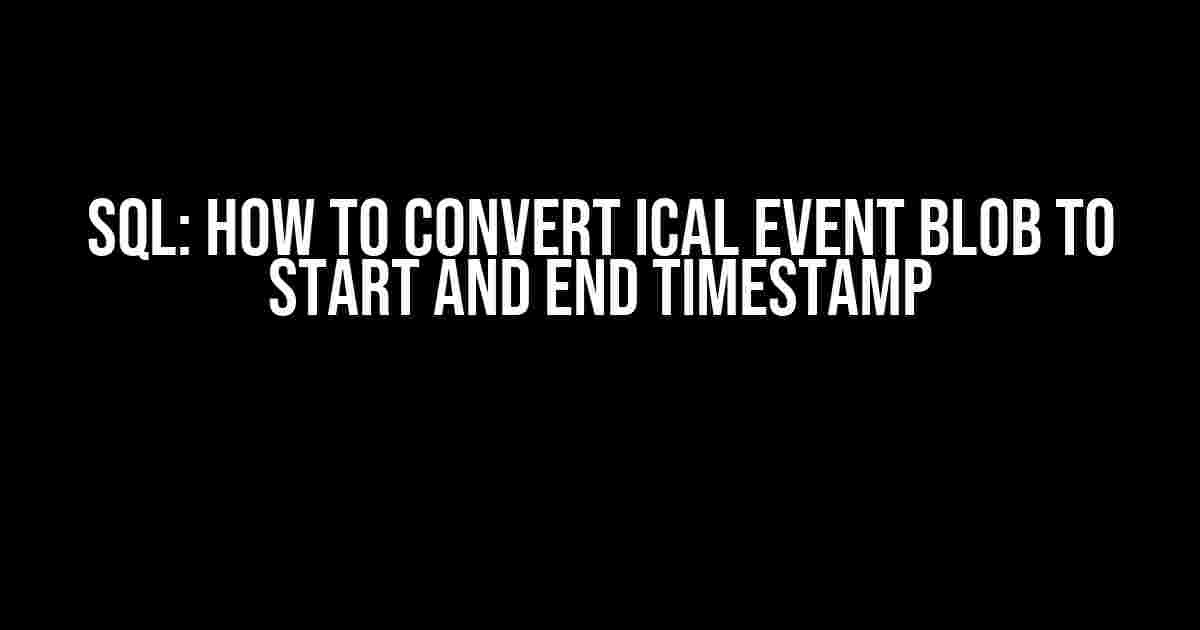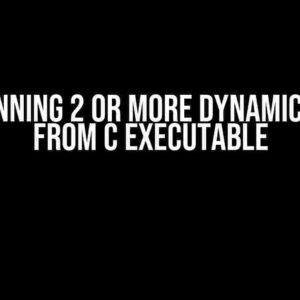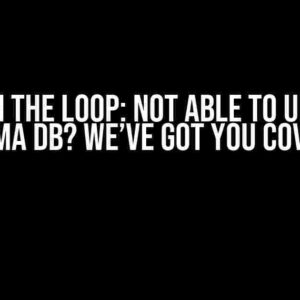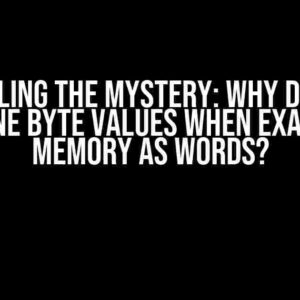Are you tired of dealing with iCal event blobs in your SQL database? Do you want to extract the start and end timestamps from those pesky blobs? Look no further! In this article, we’ll take you on a step-by-step journey to convert iCal event blobs to start and end timestamps using SQL.
What is an iCal event blob?
Before we dive into the conversion process, let’s quickly discuss what an iCal event blob is. An iCal event blob is a binary data type that stores calendar event information, such as start and end dates, recurrence rules, and event summaries. iCal event blobs are commonly used in databases to store calendar data, but they can be a pain to work with, especially when you need to extract specific information.
Why convert iCal event blobs to start and end timestamps?
Converting iCal event blobs to start and end timestamps is essential for various reasons:
- Easier data analysis: With start and end timestamps, you can perform data analysis and generate reports using standard SQL functions.
- Better data visualization: Start and end timestamps enable you to create visually appealing charts and graphs to showcase event trends and patterns.
- Improved data integration: By converting iCal event blobs to start and end timestamps, you can integrate calendar data with other systems and tools that require timestamp-based data.
Converting iCal event blobs to start and end timestamps using SQL
Now, let’s get to the good stuff! We’ll use a combination of SQL functions and string manipulation techniques to extract the start and end timestamps from iCal event blobs.
Step 1: Extract the iCal event blob as a string
First, we need to convert the iCal event blob to a string using the `CONVERT()` function:
SELECT CONVERT(event_blob, CHAR(1000)) AS event_string FROM your_table;
This will convert the iCal event blob to a string, which we’ll use in the next steps.
Step 2: Extract the start and end dates using regular expressions
We’ll use regular expressions to extract the start and end dates from the event string:
SELECT
REGEXP_EXTRACT(event_string, r'DTSTART:(.*);') AS start_date,
REGEXP_EXTRACT(event_string, r'DTEND:(.*);') AS end_date
FROM (
SELECT
CONVERT(event_blob, CHAR(1000)) AS event_string
FROM
your_table
) AS subquery;
In this example, we’re using the `REGEXP_EXTRACT()` function to extract the start and end dates from the event string. The regular expression patterns `DTSTART:(.*);` and `DTEND:(.*);` match the start and end dates, respectively.
Step 3: Convert the extracted dates to timestamp format
Now, we’ll convert the extracted dates to timestamp format using the `TIMESTAMP()` function:
SELECT
TIMESTAMP(start_date, 'YYYYMMDDTHHMMSSZ') AS start_timestamp,
TIMESTAMP(end_date, 'YYYYMMDDTHHMMSSZ') AS end_timestamp
FROM (
SELECT
REGEXP_EXTRACT(event_string, r'DTSTART:(.*);') AS start_date,
REGEXP_EXTRACT(event_string, r'DTEND:(.*);') AS end_date
FROM (
SELECT
CONVERT(event_blob, CHAR(1000)) AS event_string
FROM
your_table
) AS subquery
) AS subquery;
In this example, we’re using the `TIMESTAMP()` function to convert the extracted dates to timestamp format, using the `YYYYMMDDTHHMMSSZ` format string.
Real-world example: Converting iCal event blobs in a calendar database
Let’s say we have a calendar database with a table called `events` that stores iCal event blobs in a column called `event_data`. We want to create a view that extracts the start and end timestamps from these blobs. Here’s an example SQL code:
CREATE VIEW event_timestamps AS SELECT event_id, TIMESTAMP(REGEXP_EXTRACT(CONVERT(event_data, CHAR(1000)), r'DTSTART:(.*);'), 'YYYYMMDDTHHMMSSZ') AS start_timestamp, TIMESTAMP(REGEXP_EXTRACT(CONVERT(event_data, CHAR(1000)), r'DTEND:(.*);'), 'YYYYMMDDTHHMMSSZ') AS end_timestamp FROM events;
This view extracts the start and end timestamps from the iCal event blobs in the `event_data` column and returns them in a clean and readable format.
Conclusion
In this article, we’ve shown you how to convert iCal event blobs to start and end timestamps using SQL. By following these steps, you can extract valuable information from iCal event blobs and make it easier to analyze and visualize your calendar data.
Remember, the key to successful iCal event blob conversion is to:
- Extract the iCal event blob as a string
- Extract the start and end dates using regular expressions
- Convert the extracted dates to timestamp format
By mastering these steps, you’ll be able to unlock the secrets of iCal event blobs and take your calendar data analysis to the next level!
| Keyword | Description |
|---|---|
| iCal event blob | A binary data type that stores calendar event information |
| CONVERT() | A SQL function that converts a data type to another |
| REGEXP_EXTRACT() | A SQL function that extracts a pattern from a string using regular expressions |
| A SQL function that converts a string to a timestamp format |
We hope this article has been helpful in your SQL journey. Happy querying!
Here are 5 Questions and Answers about “SQL: How to convert iCal event blob to start and end timestamp”:
Frequently Asked Question
Get the inside scoop on converting iCal event blobs to start and end timestamps with these frequently asked questions!
What is an iCal event blob, and why do I need to convert it to timestamps?
An iCal event blob is a binary data object that stores event information, such as start and end dates, in a proprietary format. Converting it to start and end timestamps allows you to work with the data in a more human-readable format and perform queries or analytics on the event data.
How do I extract the start and end timestamps from an iCal event blob in SQL?
You can use the `PARSE` function in SQL to extract the start and end timestamps from an iCal event blob. For example: `SELECT PARSE(ical_event_blob, ‘DTSTART;VALUE=DATE:%Y%m%dT%H%M%SZ’) AS start_timestamp, PARSE(ical_event_blob, ‘DTEND;VALUE=DATE:%Y%m%dT%H%M%SZ’) AS end_timestamp FROM your_table;`
What if my iCal event blob contains recurring events? How do I handle those?
Recurring events can be tricky! You’ll need to use a combination of SQL functions and string manipulation to extract the recurring event rules and expand them into individual events. One approach is to use a recursive common table expression (CTE) to generate the individual events.
Can I use a third-party library or tool to convert iCal event blobs to start and end timestamps?
Yes, there are several third-party libraries and tools available that can help you convert iCal event blobs to start and end timestamps. For example, in Python, you can use the `icalendar` library to parse the iCal data and extract the timestamps. In SQL, you can use user-defined functions (UDFs) or stored procedures to perform the conversion.
How do I test and validate the converted start and end timestamps to ensure they’re accurate?
To test and validate the converted timestamps, you can compare them with the original iCal event data or use a third-party tool to verify the accuracy. You can also write unit tests or integration tests in your SQL code to ensure the conversion function is working correctly.
Let me know if you want me to make any changes!




